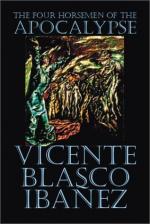Hidden under the branches, in order to escape the observation of the enemy’s birdmen, the French cannon were scattered among the hills and hollows of the highland range. In this herd of steel, there were enormous pieces with wheels reinforced by metal plates, somewhat like the farming engines which Desnoyers had used on his ranch for plowing. Like smaller beasts, more agile and playful in their incessant yelping, the groups of ’75 were mingled with the terrific monsters.
The two captains had received from the general of their division orders to show Senator Lacour minutely the workings of the artillery, and Lacour was accepting their observations with corresponding gravity while his eyes roved from side to side in the hope of recognizing his son. The interesting thing for him was to see Rene . . . but recollecting the official pretext of his journey, he followed submissively from cannon to cannon, listening patiently to all explanations.
The operators next showed him the servants of these pieces, great oval cylinders extracted from subterranean storehouses called shelters. These storage places were deep burrows, oblique wells reinforced with sacks of stones and wood. They served as a refuge to those off duty, and kept the munitions away from the enemy’s shell. An artilleryman exhibited two pouches of white cloth, joined together and very full. They looked like a double sausage and were the charge for one of the large cannons. The open packet showed some rose-colored leaves, and the senator greatly admired this dainty paste which looked like an article for the dressing table instead of one of the most terrible explosives of modern warfare.
“I am sure,” said Lacour, “that if I had found one of these delicate packets on the street, I should have thought that it had been dropped from some lady’s vanity bag, or by some careless clerk from a perfumery shop . . . anything but an explosive! And with this trifle that looks as if it were made for the lips, it is possible to blow up an edifice!” . . .
As they continued their visit of investigation, they came upon a partially destroyed round tower in the highest part of the mountain. This was the most dangerous post. From it, an officer was examining the enemy’s line in order to gauge the correctness of the aim of the gunners. While his comrades were under the ground or hidden by the branches, he was fulfilling his mission from this visible point.
A short distance from the tower a subterranean passageway opened before their eyes. They descended through its murky recesses until they found the various rooms excavated in the ground. One side of the mountain cut in points formed its exterior facade. Narrow little windows, cut in the stone, gave light and air to these quarters.




